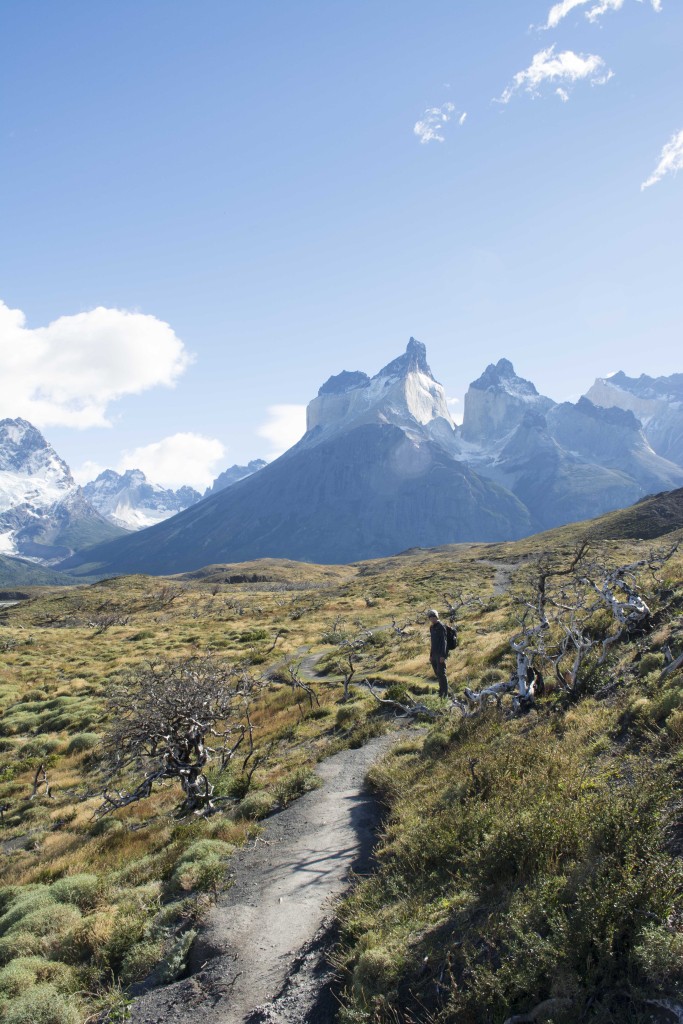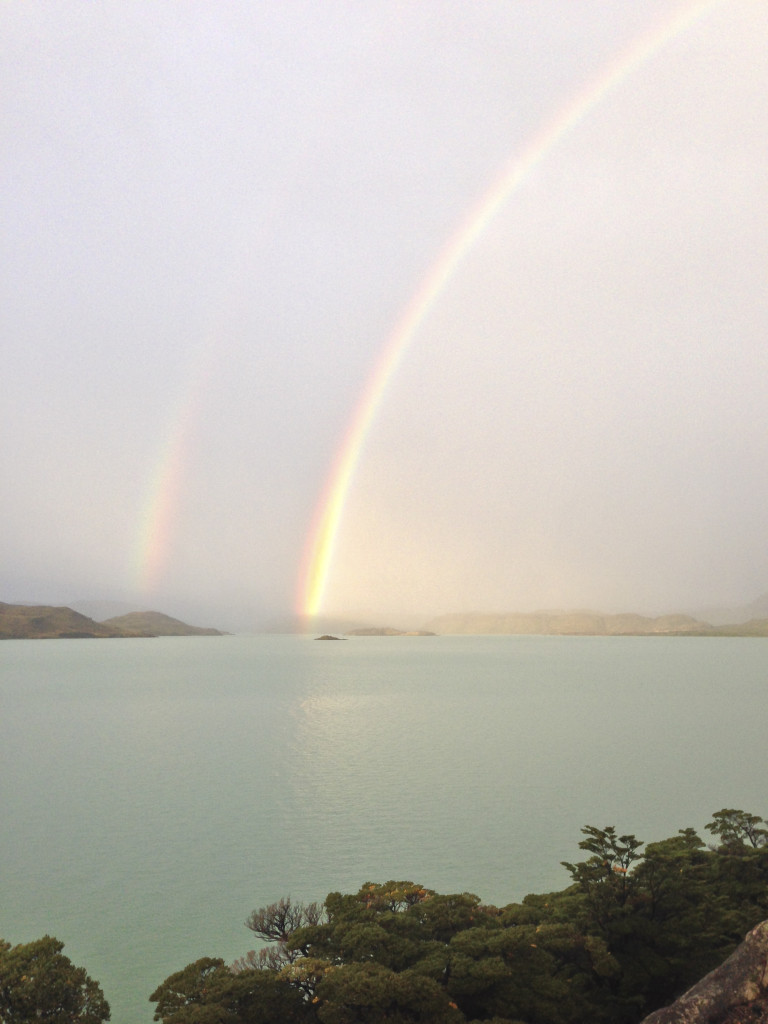
First of all, make sure you’re aware of the highlights. It’s a tough walk but nothing that a reasonably fit person can’t handle especially if you’re not camping and carrying 15kgs of gear on your back.
Dealing with the wind
People talk a lot about the wind in Patagonia. I didn’t really know what to expect but I’ve never experienced wind quite like it! I’ve never been a fan of walking poles but they may have saved my life a few times on the W Trek. The wind is FIERCE. People get knocked over, fall over ledges, get injured and sometimes die – all because of the wind. Take the wind seriously. It comes out of nowhere and is extremely powerful. Having poles will help you stabilise. When a gust of wind starts howling, dig your poles into the ground and stand strong against that bitch that’s trying to blow you over. We had rocks thrown at us, we were almost thrown off ledges – it was frightening. All we could do was wait until the monster bluster was over and it got to a stage where we could start walking again.
Walking through rivers/streams
River/stream levels vary depending on how much rain there’s been but chances are you’ll be walking through a few. Don’t risk standing on stones or logs to try and keep dry. If a lethal gust of wind strikes while you’re perched precariously on a rock, you might be finishing your walk a lot sooner than you think. Torres del Paine is not an easy park to rescue anyone from either. Just use your walking sticks for some strength against the current and walk through it. You’ll soon dry off and you’ll probably be pretty wet already.
Keep your stuff dry
If you’re camping or even staying at refugios, make sure that everything in your bag, especially your precious dry clothes, stay dry. Rucksack covers aren’t very useful in the park as they tend to get blown away by the wind or go missing. We saw tents being blown away so your rucksack cover hasn’t got much chance of staying put.
The best way to keep things dry is to wrap everything inside your bag in plastic bags or bin liners.
Bin liners are extremely useful when you’re camping as the ground is so muddy. When you are taking things out of your bag you often don’t have anywhere dry to put things. If everything is wrapped up in a liner then you can at least put things on the ground/in the rain without worrying about them getting wet.
What to Wear on the W Trek
You only need two sets of clothes. Acwalking uniform which will get wet and very muddy, and your dry non-walking uniform.
Walking Uniform
Your walking uniform should be trekking pants and one long sleeve top (preferably a wicking fast drying material and some walking socks. Cut offs and tshirts are fine but the sun is extremely strong at Torres del Paine, (apparently because the Ozone layer has been destroyed by the atmosphere reflected back up to it from the glaciers in the Patagonian Ice Fields) so long sleeves are best. Take plenty of sun screen if you don’t have a long sleeve walking top.
Dry Uniform
Take something light weight and warm that you can wear when you’re not walking.
Waterproofs
We were advised against using waterproof gear because of its lack of breathability. I get extremely hot so took off my waterproof jacket even though it was pouring with rain. I did get very wet, but it was so windy, that I was dry within a few minutes after the rain stopped. Having said that, the vast majority of people continued to wear their waterproof jackets and had waterproof trousers too, so do whatever works for you.
If it’s raining heavily, chances are that you’ll be walking through lots of streams and between Las Torres and Grey, several rivers. I wore gaiters and found that they were quite effective although my feet did get drenched after crossing a raging river on our way up Valles del Francais.
Basically, get used to being wet and muddy the whole time. So long as you have some warm dry clothes to change into later, then you shouldn’t be worrying about getting wet.
What to take with you on the W Trek?
You don’t need much, especially if you’re not camping. Resist the urge to take more. We met people carrying 20kgs of stuff – that’s insane! Don’t make things harder on yourself, take less and you’ll enjoy the walk much more.
If you’re staying at refugios, take this list as a minimum:
1. Wooly hat
Take one that won’t get blown off your head by the wind. The wind will burn your ears if you don’t have anything. I felt like I was being stabbed in both ears when I was just in Puerto Natales and had to buy a second hat.
If you’re camping, consider taking a spare hat that you can use when you’re dry and another one when you’re walking/getting wet. If you have a dry hat while you’re camping it will help keep you warm when you sleep);
2. Gloves
You don’t need waterproof or large skiing ones. Unless you are going in winter or there is lots of snow, liners should be fine.
3. One pair of trekking pants;
4. One long sleeved top for walking;
5. One pair of pants to wear in the evening;
6. One top to wear in the evening;
7. Clothes to sleep in
It gets quite hot in the refugios so maybe bring some shorts or a tshirt.
8. Jacket/fleece
This will be useful to wear in the evenings or when its cold.
9. Waterproofs
If you are that way inclined;
10. Snacks
Buy these before you get to the park if you can. They are expensive to buy in the park. Supplies between Paine Grande and Las Torres are also very limited.
11. Rucksack
12. Shoes with good grip.
I’m a big fan of ankle support but there were plenty of people walking in trainers.
13. Good walking socks
I find that liners help minimise blisters.
14. Blister plasters;
15. Toiletries and small towel
Since you have the luxury of being able to have hot showers, take some soap, shampoo (if you want), towel. Some toothbrush, and toothpaste too.
16. Plastic sandals
These are great for the showers if they don’t look too clean and it’s always nice to let your feet breathe after walking.
17. Sleeping bag liner
If you’re hiring a sleeping bag these are invaluable. Although to be fair, the sleeping bags we hired did look like they had been cleaned. If you don’t mind carrying it, you can take your own sleeping bag with you.
18. Gaiters
These are useful for giving your shoes and the bottom half of your trousers a little more protection. My favourite are the eVent (more breathable than Gore TeX) ones from Rab – they’re a good investment and very durable);
19. Walking poles
You can rent them in Puerto Natales, but if you’re going to be hiking in Tierra del Fuego and/or El Chalten or anywhere else on your trip, then consider buying some instead. (We managed to buy them in Puerto Natales for the same price as it would cost to hire them).
20. Sun hat
Useful if it’s the type you can tie to your head, otherwise it will just get blown off.
21. Water bottle
Stream water is safe to drink and you can refill in lots of places.
22. Sunglasses
23. Good head torch with spare batteries
If you’re on your own, consider a back up light in case your light fails completely.
24. Camera with lots of memory cards
If you’re camping, you’ll need all of the above (sans shower kit) plus:
25. Tent
26. Camping matt
You need it for insulation more than anything.
27. Four season sleeping bag and maybe a liner
We spoke to people who were literally freezing and got no sleep so take a good one.
28. Camping stove;
29. Cooking equipment and utensils
30. Breakfast
Porridge is useful, but heavy. Pre mix it with some sugar and maybe some hot chocolate. Alternatively take cuppa soups and a few cereal bars with you. Other people swear by hard boiled eggs.
31. Lunch
We were advised to power on using snack bars and chocolate in order to minimise stops to a few minutes at a time.
32. Dinner
Take some dried Batchelor packet type food – pasta and fat are the most important things you need. If you’re staying at a Refugio camp site one night e.g. Los Cuernos, then consider getting a hot dinner there too.
Water
You shouldn’t need to boil or sterilise the water you find in the park before you drink it. Water in the park is plentiful and should be drinkable without you having to treat it. We drank buckets of untreated stream water and didn’t get sick. You don’t need to take water with you and you don’t need to buy it when you are in the park.
Don’t forget to also check out the following posts on the W Trek:
How to Get to Torres del Paine

One thought on “Hiking the W Trek – All You Need to Know”
Comments are closed.